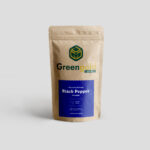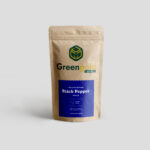Black pepper, also known as the “king of spices,” is not only a delicious addition to your meals but also a wonderful plant to grow at home. Whether you have a garden or an indoor space, you can easily grow black pepper plants with the right care and conditions. 🌿
In this guide, we’ll walk you through the steps of growing your own black pepper plant, from planting to harvesting. 🌱 Let’s get started and bring the flavor of fresh black pepper right to your kitchen!
👉 Shop premium black pepper plants and gardening supplies at Greengold Guide!
1. Understanding the Black Pepper Plant 🌱
Before you begin planting, it’s important to understand the basics of the black pepper plant (Piper nigrum). Black pepper is a tropical vine that grows in warm, humid climates. The plant produces small, peppercorns that are harvested, dried, and used as the black pepper we know and love.
Key Growing Conditions for Black Pepper:
- Temperature: Black pepper thrives in warm temperatures between 75°F to 85°F (24°C to 29°C).
- Humidity: High humidity (60% or more) is essential for proper growth.
- Sunlight: The plant prefers indirect sunlight and should be protected from harsh afternoon sun.
2. Choosing the Right Growing Location 🏡
Black pepper plants need a spot with plenty of indirect sunlight if you’re growing them indoors or in a greenhouse. If you’re planting outdoors, make sure to choose a location that provides a combination of sunlight and shade to protect the plant from intense heat.
Indoors:
- Use a bright windowsill or a grow light to ensure the plant gets enough light.
- Keep the temperature between 70°F to 85°F (21°C to 29°C) and maintain high humidity by placing the plant near a humidifier or using a misting spray. 🌬️
Outdoors:
- Choose a spot that’s protected from strong winds and direct sunlight for most of the day. 🌞
- Black pepper vines can also be trained to grow on a trellis or support structure for vertical growth. 🌱
3. Planting Black Pepper Seeds or Cuttings 🌿
There are two main ways to propagate black pepper: seeds or cuttings. Both methods can be effective, but growing from cuttings is usually faster.
Option 1: Growing from Seeds 🌱
- Soak black pepper seeds in warm water for about 12 hours before planting.
- Plant the seeds about 1/4 inch deep in a well-draining potting mix.
- Place the pot in a warm location with indirect light. Keep the soil consistently moist but not soggy.
Option 2: Growing from Cuttings 🌿
- Take a healthy cutting of a black pepper vine that’s about 4 to 6 inches long.
- Remove any leaves from the bottom of the cutting and dip it in rooting hormone (optional).
- Plant the cutting in a pot with well-draining soil and keep it in a warm, humid environment. 🌱
- Water it regularly and expect roots to develop in about 2-3 weeks.
4. Caring for Your Black Pepper Plant 🌿
Once your black pepper plant is established, proper care will help it grow strong and healthy. Here are some key tips for caring for your black pepper vine:
Watering 💧
- Keep the soil moist but not waterlogged. Black pepper plants need consistent moisture, especially in warm, dry conditions.
- Use well-draining soil to avoid root rot. 🌱
Fertilizing 🌾
- Feed your black pepper plant with a balanced liquid fertilizer every 2-3 weeks during the growing season (spring and summer).
- During the winter, reduce fertilization as the plant’s growth slows down. 🌟
Pruning ✂️
- Prune your black pepper vine to encourage bushy growth. Pinch off the tips of the vine to promote side shoots and a fuller plant.
- Remove any dead or yellowing leaves to keep the plant healthy. 🌿
Support Structure 🌱
- Black pepper vines need support as they grow. Use a trellis, plant stake, or string to help the vine climb upward. This encourages vertical growth and makes harvesting easier. 🏡
5. Harvesting Black Pepper 🌶️
Black pepper plants take about 3-4 years to mature and produce peppercorns. Here’s when and how to harvest them:
- The peppercorns start out green and gradually turn red as they ripen. For black pepper, harvest the peppercorns when they’re red, then dry them to turn them into black pepper. 🌶️
- To harvest, cut the entire cluster of peppercorns from the vine and allow them to dry in a warm, dry area for a few days.
- Once dried, you can grind the peppercorns to create your own freshly ground black pepper! 🌿
6. Common Issues and Solutions ⚠️
While black pepper is a relatively easy plant to grow, it can encounter a few common issues:
Yellowing Leaves 🍂
- This may be a sign of overwatering or poor drainage. Ensure the plant is in well-draining soil and reduce watering if the soil feels soggy. 🌱
Pest Problems 🐞
- Keep an eye out for spider mites or aphids, which can sometimes affect pepper plants. Use natural pest control methods, like neem oil, to keep pests away. 🌿
Poor Growth 🌱
- If your black pepper plant isn’t growing as expected, it could be due to a lack of sunlight or humidity. Ensure the plant is in a warm, bright spot and consider using a humidifier to boost the humidity. 🌬️
7. Tips for Success 🌟
- Humidity is key! Black pepper plants thrive in humid conditions, so consider using a humidifier or misting the plant regularly, especially if you’re growing it indoors. 🌿
- Be patient! Black pepper plants grow slowly and may take a few years before they produce peppercorns, but it’s definitely worth the wait. 🌱
- Prune regularly to encourage strong, bushy growth. 🌿
- Support the vine early on with a trellis or support to ensure it grows properly. 🌱
🌿 Final Thoughts
Growing black pepper at home can be a rewarding experience, and the satisfaction of harvesting your own freshly ground pepper is hard to beat! Whether you have a small indoor space or a large outdoor garden, black pepper is an excellent plant to grow with just a little care and patience. 🌱
At Greengold Guide, we’re passionate about offering the best gardening tools and natural products to help you grow and enjoy your own healthy, organic black pepper. Start your black pepper-growing journey today and enjoy the flavor and benefits of this amazing spice! 🌶️
👉 Shop premium black pepper plants and gardening supplies now at Greengold Guide!


